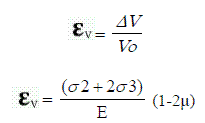EXPERIMENTAL, ANALYTICAL AND THEORETICAL SLOPE STABILITY ANALYSIS WITH DIFFERENT MATERIALS AND METHODS
EXPERIMENTAL, ANALYTICAL AND THEORETICAL SLOPE STABILITY ANALYSIS WITH DIFFERENT MATERIALS AND METHODS
ANÁLISIS EXPERIMENTAL, ANALÍTICO Y TEÓRICO DE ESTABILIDAD DE TALUDES CON DIFERENTES MATERIALES Y MÉTODOS
ABDOULLAH NAMDAR
Mysore University,
Mysore, India
ab_namdar@yahoo.com
AZAM KHODASHENAS
PELKO
Mysore University,
Mysore, India
ab_namdar@yahoo.com
Recibido para evaluación: 17 de Diciembre de 2009 / Aceptación: 13 de Mayo de 2010 / Recibida versión final: 21 de Mayo de 2010
ABSTRACT
Slopes are usually constructed from soil, although natural soil or mixed soil are also in use or have proposed. This paper deals with evaluation of slope stability. It is understood possibility approaching certain level of slope stability based on experimental, theoretical and analytical methods. Result revealed that mixed soil characteristics could resist sufficient for static force based on appearing acceptable safe bearing capacity and for evaluation of shear stressstrain slope when is under seismic force using shaking table along with the theoretical and analytical methods provided concrete evidence for slope design at any part of slope.
KEY WORDS: Stability; Seismic Force; Shaking Table; Poisson ratio
RESUMEN
Los taludes se construyen normalmente del suelo. Este artículo trata sobre la evaluación de estabilidad del talud. Entendiéndose por tal la posibilidad de acercarse a cierto nivel de estabilidad del talud sobre la base experimental, teórica y los métodos analíticos. Los resultados revelan que las características del suelo mixtos pueden resistir la fuerza estática suficiente basada en la capacidad de rodamiento segura y aceptable para la evaluación de la pendiente de corte de tensión-deformación cuando se está utilizando la fuerza sísmica mesa vibradora, junto con los métodos teóricos y analíticos proporcionan pruebas concretas para el diseño de la pendiente en cualquier parte del talud.
PALABRAS CLAVES: Estabilidad; Fuerza Sísmica; mesa vibradora, un cociente de Poisson
1. INTRODUCTION
The potential of
major catastrophic slope failure, both in terms of human safety as well as
economy loss, underlines the critical importance of efficient and reliable
design.
A tragic slope
failure occurred in Manshiet Naser area in 1993 and caused many casualties and
property damage [1]. On January 10, 2005, a steep slope behind the housing
development at La Conchita, failed cascading approximately 400,000 tones of
debris, and killed 10 people, buried 13 homes and damaged 18 [2]. It has been
reported a realcoded genetic algorithm (GA), this is used to find out the
factor of safety for the soil slopes using wedge method. The analysis is
formulated as constrained optimization problem to solve the nonlinear
equilibrium equation and finding out the factor of safety [3]. There is an
investigation on the stability of slope. It is one of the most important
problems in stability analysis of geomechnics. The limit equilibrium method
used and it is taken as 2D plane strain problem with no variation in geometry,
material and surcharge in direction parallel to the crest of the slope. The
problem lies in finding out the critical failure surface and its corresponding
factor of safety (FOS) [4-5]. It is presented the threewedge method for
stability analysis of slopes; this is a force equilibrium method [6].
There is a scientific research on different moisture contents of rock and soil,
it can influence the slope stability, especially for the weathered state, it is
much sensitive to water. Based on water character experiment of completely
weathered state, and according to the wedge theory under plane strain
condition, analysis is proposed on not only the stress field of the excavation
of high cut slope but also on the excavation disturbance effect under different
moisture content according to Mole-Coulomb strength criterion and uniaxial
tensile strength criterion after safety margin, which could provide theoretical
support to the actual excavation works and effective reinforcements [7]. It has
been studied influence of root trees on slope stability and different factors
like slope geometry and gradient, geologic materials, stratigraphy, hydrology,
and the local effects of shore processes have been analyzed [8]. The purpose of
this paper is evaluation of 31 mixed soil characteristics for slope stability
when it is under static force and analysis of shear stressstrain slope when is
under seismic force based on using shaking table.
2. METHODOLOGYAND EXPERIMENTS
Earth slopes are formed for railway formation, highway embankment, earth dam, canal banks and many earth structures. In slope construction from mixed soil for increasing slope stability, different types of soil with proper percentage is best option employed, in this regard 31 mixed soil types from red plastic soil and black, green, dark brown, yellow and light brown non plastic soils, sand, and two types of gravels (2 mm, 4.75 mm) developed, and also safe bearing capacity, angle of friction, unit weight and cohesive of mixed soils sample presented (table 12) [9]. In the present experiments, a transparent rigid boundary acrylic box with opening at the top has used to study the behavior of embankment in fully saturated ground. The box is made of perplex glass of thickness 12 mm with dimensions of 1650 mm in length, 500 mm in breadth and 600 mm in depth. The bottom portion of box has an arrangement of baffle walls for regulating water uniformly to saturate the sand placed in the box. Small orifice is provided at the bottom to allow water for saturation of the model. Filter plates with size of 2 micron were provided above the baffle walls, which could be easily removed and placed back. The use of filter plates helped in restricting the entry of sand into the baffle wall portion. The outer surface of the acrylic box was marked with grids of 100 mm by 100 mm using a permanent marker in order to lay the color sand in proper layers. The manual-shaking table has used to vibrate in one direction. It consisted of two wooden panels with steel plates between them for producing harmonic vibration at frequency of 1 Hz to 3 Hz. The thickness, height and number of plates were so designed to achieve a relatively rigid platform and to vibrate at resonance. The platform was 1.8 m long, 0.6 m wide and 0.35 m in depth. The steel plates were bolted between the top and bottom surfaces of the wooden panels using angle sections. The acceleration sensors (A1A3) were used to measure acceleration developed during dynamic loading (Figure1). The respective transducers were connected to their signal conditioners. These were in turn connected to the C. P. U of a computer. The shaking table used for seismic performance assessment of embankment fully vulnerable against liquefaction [10]. The embankment experimental model is considered in Figure 1 with the cross section of ground level with sand, water level and positions of pore pressure and acceleration sensors for understanding seismic embankment model behavior. In this investigation the modulus of elasticity, a property of elastic material, is defined as a constant of proportionality between stress and strain as [11].

Figure 1. position of transducer
We may also take volumetric measurement as the test proceeds, which require completely filling the cell with a liquid during sample consolidation. If we measure the change in sample volume ΔV , the volumetric stain can be compute as [10]
Table 1 Mixed soil
models [12]
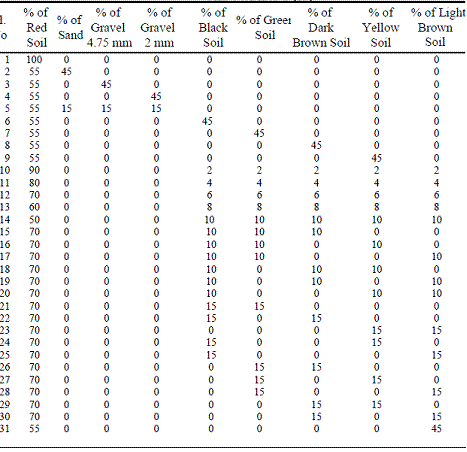
3. RESULTS AND DISCUSSION
It is observed all
load sustainability, deformation, settlement and reliability and safety of soil
structure is not only depending on strength of material, but soil structure
geometry has also played one of the important factors in the design and
analysis of slope [9].
For analysis of slope
stability during the collapse the result of shaking table has been used which are
indicated in the Table 2-Table 3 and Figure 2-4, the result also used for finding
soil properties as following Soil properties
during the shaking under the embankment in the subsoil is equal
Table 2. typical
characteristics of test moist loose embankment and subsoil with full saturated
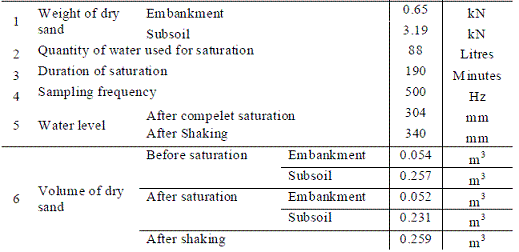
Table 3. details of
acceleration characteristics test by shaking table [13]
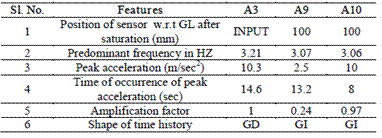
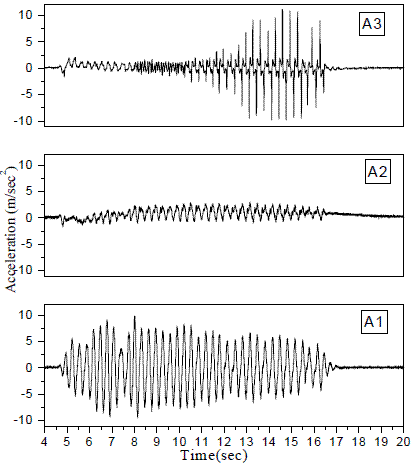
Figure 2. Acceleration time histories in shaking table test [13]
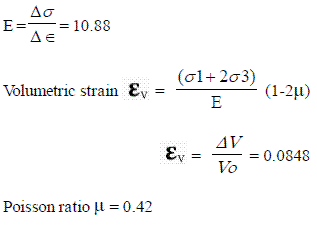
Soil properties during the shaking away from the embankment in the subsoil is equal
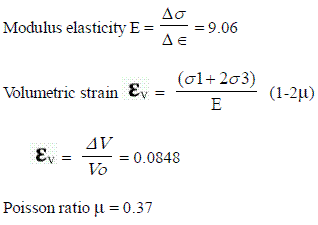
A value of 0.5 for Poisson ratio is usually used for saturated soils, [10] from the obtained Poisson ratio in this investigation could indicate validity of experimental and calculation. The Poisson ratio is obtained from the shaking table test is close to value assumed previously by other scientist, the passion ratio is reduced during the shaking, the lateral force in the subsoil reduced passion ratio, and it is occurred in maximum intensity at away of under embankment in subsoil.
As per data presented in the table 4 based on any slope geometry, could analysis slope stability but reason of using shaking table and finding of passion ratio during shaking is achieving accurate soil mechanical properties at any part of slope at the time of earthquake.
Table 4. experiments results of mixed soil under loose OMC condition [12]
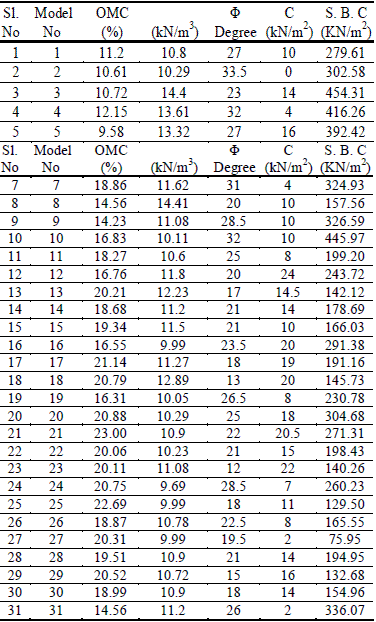
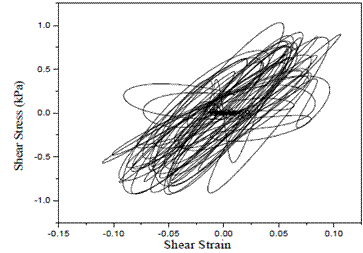
Figure 3. Stress
strain history in the subsoil away from embankment

4. CONCLUSI
- Simulation
technique based on theoretical and analytical concept used to evaluation slope
stability characteristics
- The Poisson ratio is obtained from the shaking table test is close to value assumed previously by other scientist[10], it is an evidence of experimental accuracy, the passion ratio is reduced during the shaking, lateral force in the subsoil reduced passion ratio this is occurred in maximum intensity at away of under embankment in subsoil, this is reason accelerated slope failure
REFERENCES
[01] Mahmoud S.M. Y., 2000. Slope Stability of the Middle Eocene Rocks of Gebel, ICEHM, Cairo University, Egypt, September, pp. 1432
[02] http://www.saboint.org/case/la__conchita_mudslide.pdf
[03] Sarat Kumar D., 2005. Slope Stability Analysis Using Genetic Algorithm, EJGE,
[04] Basudhar, P.K., 1976. Some applications of mathematical programming technique to stability problems in geotechnical engineering, Ph.D. Thesis, Indian Institute of Technology, Kanpur, India.
[05] Baker, R., 1980. Determination of the critical slip surface in slope stability computation, International J. of Numerical and Analytical methods in Geomechanics, Vol.14, pp. 333-359
[06] Huang, Y.H.. 1983. Stability analysis of slopes, Van Nostrand Reinhold Company, USA.
[07] Fu, Helin et al., 2009. Analysis of the Excavated Disturbance Effect of High Cut Slope in Completely Weathered State under Different Moisture Contents, EJGE, Vol. 14, Bund. E
[08] Www.Greenbeltconsulting.com
[09] Abdoullah N., 2010. Analysis of Slope Stability using Limit Equilibrium, Buletinul Institutului Politehnic Din Iasi, Universitatea Tehnica, Gheorghe Asachi, din Iasi, Tomul LV (LIX), Fasc. 2, Secsia, Construcţii Ărhitectura
[10] Abdoullah N., 2009. Seismic Evaluation of Sandy Embankment Model, Buletinul Institutului Politehnic Din Iasi, Universitatea Tehnica "Gheorghe Asachi" din Iasi, Tomul LV (LIX), Fasc. 3
[11] Joseph E. B., 1979. Physical and Geotechnical Properties of Soils, McGrawHill, United States of America
[12] Abdoullah N., et al., 2009. Bearing and liquefaction evaluation of mixed soils, Ingenierías, Vol. XII, No. 44
[13] Abdoullah N., et al ., 2008., Seismic Mitigation of Embankment by Using Dense Zone in Subsoil, Emirates Journal for Engineering Research, 13 (3), pp. 55-61
NOMENCLATURE
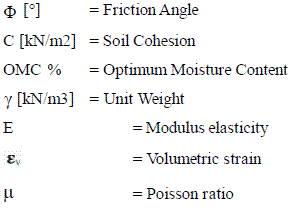
Cómo citar
APA
ACM
ACS
ABNT
Chicago
Harvard
IEEE
MLA
Turabian
Vancouver
Descargar cita
Visitas a la página del resumen del artículo
Descargas
Licencia
Derechos de autor 2010 Boletín de Ciencias de la Tierra

Esta obra está bajo una licencia internacional Creative Commons Atribución-NoComercial-SinDerivadas 4.0.
El autor o autores de un artículo aceptado para publicación en cualquiera de las revistas editadas por la facultad de Minas cederán la totalidad de los derechos patrimoniales a la Universidad Nacional de Colombia de manera gratuita, dentro de los cuáles se incluyen: el derecho a editar, publicar, reproducir y distribuir tanto en medios impresos como digitales, además de incluir en artículo en índices internacionales y/o bases de datos, de igual manera, se faculta a la editorial para utilizar las imágenes, tablas y/o cualquier material gráfico presentado en el artículo para el diseño de carátulas o posters de la misma revista. Al asumir los derechos patrimoniales del artículo, no podrá reproducirse parcial o totalmente en ningún medio impreso o digital sin permiso expreso del mismo.




